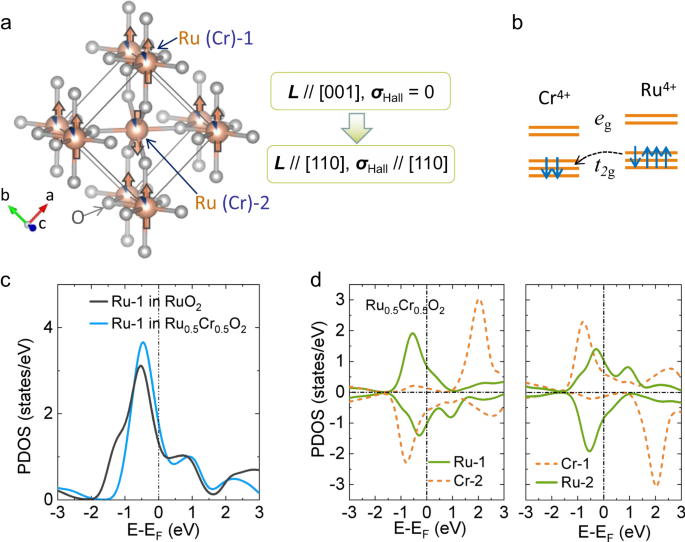
Emergent zero-field anomalous Hall effect in a reconstructed rutile antiferromagnetic metal
- Select a language for the TTS:
- UK English Female
- UK English Male
- US English Female
- US English Male
- Australian Female
- Australian Male
- Language selected: (auto detect) - EN
Play all audios:

The anomalous Hall effect (AHE) that emerges in antiferromagnetic metals shows intriguing physics and offers numerous potential applications. Magnets with a rutile crystal structure have
recently received attention as a possible platform for a collinear-antiferromagnetism-induced AHE. RuO2 is a prototypical candidate material, however the AHE is prohibited at zero field by
symmetry because of the high-symmetry [001] direction of the Néel vector at the ground state. Here, we show AHE at zero field in Cr-doped rutile, Ru0.8Cr0.2O2. The magnetization, transport
and density functional theory calculations indicate that appropriate doping of Cr at Ru sites reconstructs the collinear antiferromagnetism in RuO2, resulting in a rotation of the Néel
vector from [001] to [110] while maintaining a collinear antiferromagnetic state. The AHE with vanishing net moment in the Ru0.8Cr0.2O2 exhibits an orientation dependence consistent with the
[110]-oriented Hall vector. These results demonstrate that material engineering by doping is a useful approach to manipulate AHE in antiferromagnetic metals.
The Anomalous Hall effect (AHE) long considered as a unique feature of ferromagnetic metals, and its magnitude was empirically taken as proportional to the macroscopic magnetization M1,2. It
followed that in antiferromagnetic materials, which host zero macroscopic magnetization or only small canting moments, the AHE should be negligibly small. However, recent theoretical works
indicate that in some antiferromagnetic materials, the AHE can be expected if the magnetic space group (MSG) (or, equivalently, the magnetic point group that the MSG belongs to) allows for a
nonzero Berry curvature and/or asymmetric scattering, even if the corresponding macroscopic magnetization is zero3,4,5. Such an AHE was first demonstrated for various noncollinear
antiferromagnets with magnetic multipoles6,7,8,9,10,11,12, such as kagome Mn3Sn and pyrochlore R2Ir2O7.
a Crystal structure of the Cr-doped rutile phase RuO2. O-ions are located between two Ru (Cr) sites asymmetrically. The Ru-1 (Cr-1) and Ru-2 (Cr-2) denote the Ru (Cr) ions at the center and
the corner sites of the unit cell, respectively. The orange arrows denote the local magnetic moment with antiferromagnetic coupling along [110]. Hall vector (σHall) is allowed and parallel
to the Néel vector (L) along [110] in such a configuration, which vanishes as the Néel vector is along [001], indicating a manipulating of L is necessary to generate AHE. b Schematic
illustration of charge transfer in Cr-doped RuO2. The orbital level difference between the nearest neighbor sites can lead to partial charge transfer from Ru4+ to Cr4+ to form a
reconstructed Fermi level and maintain an antiparallel spin coupling. c Calculated projected density of states (PDOS) of the RuO2 and Ru0.5Cr0.5O2 in the paramagnetic phase. The Ru-2 sites
for both components possess identical PDOS with Ru-1. d Calculated PDOS of the Ru0.5Cr0.5O2 in the magnetic ground state. The doped Cr ions have two selective sites as labeled by Cr-1 and
Cr-2 in (a). Ru and Cr both show an asymmetric PDOS (a spontaneous polarization), while exhibiting an antiparallel coupling.
It should be noted that the collinear antiferromagnetism in RuO2 has been questioned quite recently25. Nevertheless, considering that many previous experiments support the collinear
antiferromagnetism17,19,24,26,27, we designed the experiment by postulating that the magnetism of RuO2 at the ground state is a collinear antiferromagnetic state with the Néel vector along
[001] and interpret the experimental results with the assumption that a small amount of Cr-doping does not change the collinear antiferromagnetism but can modulate the direction of the Néel
vector. Within this approach, our magnetometry suggests that the direction of the Néel vector in the Ru0.8Cr0.2O2 film shifts to [110]. Concomitantly, we find that the Ru0.8Cr0.2O2 film
exhibits an appreciable zero-field AHE with hysteretic behavior while the net magnetization is vanishingly small. These observations are well explained by considering that the collinear
antiferromagnetism with the Néel vector along [110] is realized and that the magnetic field switches the two collinear antiferromagnetic states that are related by time-reversal operation.
To gain insight into the impact of Cr-doping on the Fermi level, we first performed DFT calculations for the paramagnetic states of Ru1-xCrxO2 for x = 0 and 0.5. As shown in Fig. 1c, by
doping Cr, the shift of the projected density of states (or, equivalently, the shift of the Fermi level) is observed, as expected. The magnetic calculation for x = 0.5 (Fig. 1d) further
demonstrates that the ground state has appreciable local magnetic moments with antiparallel couplings among the nearest-neighboring Cr and Ru ions. Note that the DFT + U calculations on RuO2
show that the energy difference with the Néel vector orienting to [001], [100], and [110] is tiny (~5 meV) and that the easy-axis direction sensitively depends on the Fermi level
(Supplementary Fig. 2)19. Our DFT results therefore support our working hypothesis that Cr doping is a promising approach to change the Néel vector direction while maintaining the collinear
antiferromagnetic order.
The DFT+DMFT results indicate that Cr doping is also accompanied by the enhancement of the local magnetic moment. For the case of non-doped RuO2, the Ru ions exhibit a negligibly small spin
polarization when U is small (
